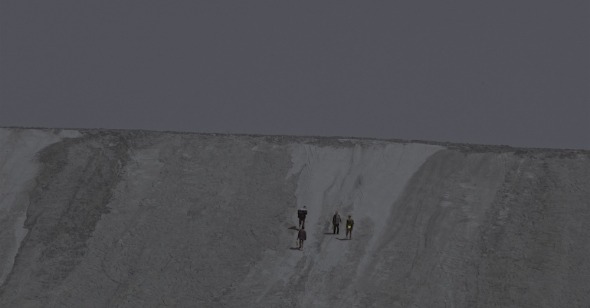Living Desert
By Michael Sicinski
The Periphery of the Base
Dir. Zhou Tao, China, no distributor
The Periphery of the Base screens March 15 at Museum of the Moving Image as part of First Look 2025, alongside Bliss Point.
Chinese filmmaker Zhou Tao could best be called a liminal figure, both in Chinese cinema and in terms of genre. Although his work has a basis in documentary, he seems primarily interested in the plasticity of images and sounds. One could argue that Zhao represents a point of synthesis between the Chinese independent documentary movement and the so-called “avant-doc” approach in the West. But while this might offer some sense of where The Periphery of the Base is coming from, it in no way describes the film itself, an object that unfurls a bit like a complex piece of classical music. Zhao introduces forms and motifs in order to stretch them to the limits of intelligibility. Before you’re even aware of it, Periphery has already moved on to some other idea.
There is an actual if minor historical event that Zhao is filming, one involving the construction of some sort of public works project in the Gobi Desert. Unlike, say, certain of Jia Zhangke’s films, which connect dislocation and erasure of communities to such projects (e.g., the Three Gorges Dam), as a kind of material metaphor, Zhao goes out of his way to conceal the broader details of the project. The title, in one sense, can be taken literally. He is filming peripheral activity and landscapes around the base camp, focusing on the edges of his chosen subject. But in another sense the title is an aesthetic statement of purpose. Zhao is not only skirting the ostensible heart of his subject but also drawing our attention to the interstitial elements within his filmed material.
In the first half, we see the vast landscape, disrupted by cars and trucks whizzing by the camera. When human figures appear, they momentarily clarify the scale of what we’re seeing, and how close or far away a given expanse of land actually is. Then there is Periphery’s lone sequence of extended dialogue, which seems designed to confuse. One man is telling another a story about breaking into someone’s house, cooking a live goose, whether or not they have chili sauce at their disposal, and other seemingly related thoughts. Taken one at a time, the phrases seem to make a bit of sense. But as he goes on, we find ourselves in the throes of verbal schizophrenia. Sentences don’t clearly build on each other, and it seems impossible to come away with a clear idea of what this man is talking about. (I must acknowledge, of course, that this might be partly due to subtitles, and that the dialogue might make more sense to a native Chinese speaker.)
Much of the rest of the film seems to consist of formalist analogues to this fractured conversation. We think we are going to observe labor, but instead only see random people wandering around, drinking bottles of pop. Close-ups of rock formations bleed into mottled skies; daylight images gradually evolve into infrared night vision. The open landscape of the worksite almost imperceptibly gives way to a bustling marketplace, an outpost quite close to a place we’d been led to believe was the middle of nowhere.
If we consider the macro-structure of Periphery, we might say that Zhao uses carefully mechanized camera movement and subtle editing to thwart our cognitive ability to make sense of this place. This could be taken as Zhao’s own analogy for life in Xi’s China, a place of economic and military uncertainty. But one does not even need to resort to political metaphors. Periphery is a film that makes conventional documentary comprehension impossible, and in so doing calls into question the ostensible purpose of documentary itself. If we learn anything—e.g., what working in the Gobi Desert is like—what is that knowledge ultimately worth? How does such a project reduce individual people, sights, and sounds into a consumable, edifying point? Even the best documentaries tend to shut meaning down. The Periphery of the Base, by contrast, is a wide-open field.
